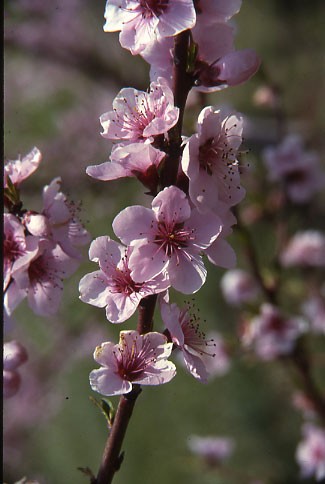A Peach of an Idea for South Florida

BY RICHARD J. CAMPBELL
FAIRCHILD TROPICAL BOTANIC GARDEN
As published in the Miami Herald
The peach is among one of life’s most wonderful natural pleasures. Soft and juicy, it calls to you with a tempting floral bouquet and decadent sweetness. Living here in South Florida, our summer memories do not naturally turn to the peach, for most of our contact is through our local grocery store. But perhaps it is time to change our ways.

Growing up in south Florida, we always had a peach tree in our home garden. This was, I suppose due to my parents’ roots that stretched back to the mid-west of the country. The ‘Red Ceylon’ peach that we grew was a direct import from China and had no chilling requirement, unlike the peaches of their youth. This meant that it would flower, fruit and grow normally following our mild Homestead winters. The fruit were quite small and not overly colorful. They were rubbery and had a good flavor, but face it; there were mangos on the tree at the same time. Needless to say the ‘Red Ceylon’ peach was not my favorite.
Then in the late 1960s the Caribbean fruit fly took hold in south Florida and began to ravage many of our favorite fruit. They loved our small peaches (much more than I did apparently) and what was a mediocre experience became a real chore, for the peaches were now riddled with maggots. You could close your eyes and swallow them, but the experience was less than ideal.
Fast forward a couple decades and we arrive at the University of Florida, Dr. Wayne Sherman and a breeding program to develop peaches with little need for chilling. Unlike the ‘Red Ceylon’, these were to be peaches with excellent eating quality, good production and an attractive appearance – bred just for us. In the horticultural world, the work of Dr. Sherman remains the stuff of legend, for his peach selections and their progeny now grow throughout the tropical regions of the world, bringing fresh peaches to those who would never have had the opportunity before. These new peaches changed our world.
South of Lake Okeechobee we now had an option besides ‘Red Ceylon’. By the late 1980s there were high quality peaches available for planting in South Florida; yet, they remain an oddity in our home landscapes. Our little friend the fruit fly is one of the main reasons, for fruit fly do not care what variety you grow, they simply love peaches. But, it is time to take a fresh look at the peach and our options.
Local tropical fruit nurseries now carry several varieties of peaches perfect for the South Florida garden. ‘Florida Prince’, ‘Tropic Snow’ and ‘UF Sun’ are all three available and well adapted.

‘Florida Prince’ needs 150 hours of chilling and is highly tolerant of our heat. The fruit are firm and yellow fleshed and ripen in May. The 150 hours of chilling make this peach perfect for most anywhere on mainland South Florida.
‘Tropic Snow’ needs 200 hours of chilling and may be a bit troublesome in deep south Florida during warm wintes. The flesh is white and freestone. They ripen in middle June and are highly attractive on and off the tree.
‘UF Sun’ has the lowest chilling requirement at 100 hours. It is a non-melting, semi-cling variety that is full red over a deep yellow flesh. It ripens in June and has good heat tolerance as well.
Regardless of the variety, the peach will grow easily as long as it receives sufficient chilling in the winter months. Peach trees will benefit from supplemental irrigation in the driest months, but remember that by irrigating you will be diluting the sugar in the fruit. The more water equals less sugar (translation: watery fruit). The fruit will be bigger, but they will disappoint.
Fertilization is best 3 times a year in June, August and October. An 8-3-9 or other fruit tree mixture is recommended. Some of our newest imported pests are causing problems on the peach, including the Sri Lanka weevil and various scales. The best control measures are monitoring, the use of predatory insects and above all patience. If you have to, soaps and other natural controls should be used before resorting to chemical treatments.
Fruit fly, however, continues to hold us back. The best solution for combating this formidable pest is to cover the individual fruit with paper bags when they are quite young. The bags should remain until harvest. The fruit will develop without any problem within the bag, except for the occasional outbreak of mealybugs.
There is nothing quite like a fresh peach picked from the tree, and unfortunately what we have in the grocery store does not do the trick. Now we have options for South Florida. Why not have the best of both worlds; the tropical and the temperate fruit? And, in late May, with peach in hand, one phone call to gloat to that relative up north is always a good idea.
